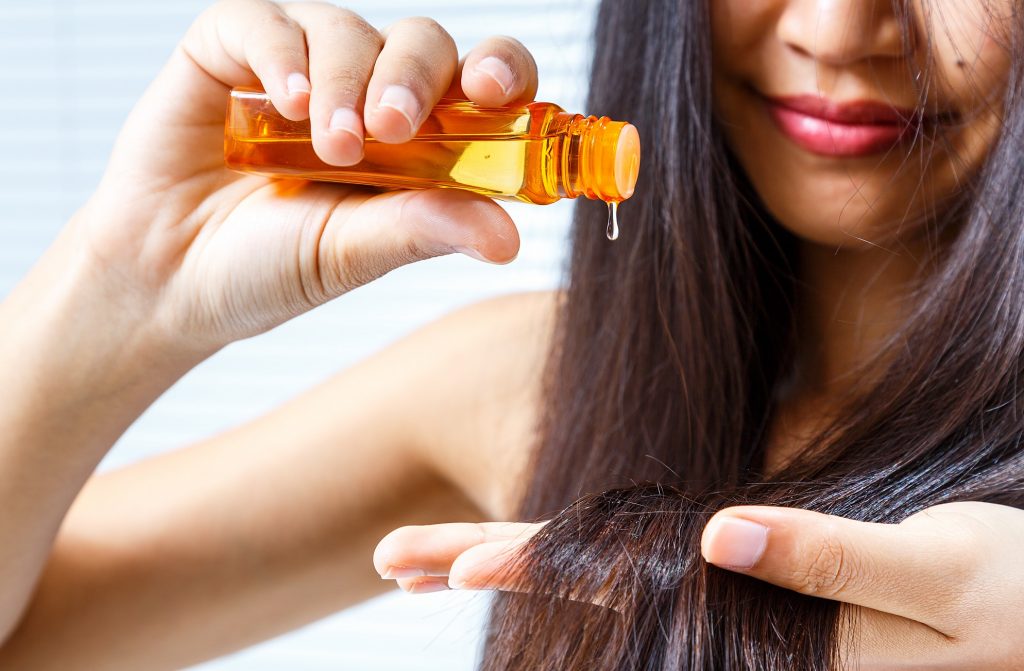In the majority of Asian countries, the most popular method of hair care is hair oiling. It is a natural and inexpensive way to maintain beautiful hair. The method can be freely modified in order to adjust it to your needs and the effects you wish to achieve. Until all women around the world try it out, it is still worth describing.
For several months, hair oiling has been a hot topic that has been picked up by the biggest cosmetic brands. Hence, the market abounds in more and more oil-based hair products. There is a wide selection when it comes to natural hair oils. Cold-pressed from various plants are so diverse that we can choose from over 150 oils.
It is time to get to know a bit more about hair oiling!
HAIR OILING – long story short, it is a beautifying treatment based on applying oil onto the hair to improve hair condition, restore shine and softness. There is a range of methods how you can apply the oil. However, the crucial thing is to match it to the structure of your hair. Keep on reading to learn more about hair porosity.
Why is hair oiling so effective?
It works so well because it provides hair with essential fatty acids, antioxidants, vitamins and phytosterols. Human hair is made of keratin fibers and covered with a protective layer of scales, for which the binders are fatty acids. That is why hair oiling is the ideal method of regenerating the strands as it seals the scales, smooths and strengthens natural protection. However, this is not all, because fatty acids are also essential for the proper functioning of the hydrolipid layer. Hair oil enriches it with valuable ingredients and enhances the protection of hair and scalp, e.g. against moisture loss. Besides, due to the different content of EFAs, the oils may have smaller or larger molecules and therefore better absorption into the hair of different porosities. These are the only care ingredients that can be matched to hair structures.
Attention! Hair oiling has its downside as well. It is a time-consuming process of gradually discovering the best solutions, choosing the most effective methods and most suitable oils. Everything has to be tried by the hit and miss way, although there are some rules we can use at the beginning of our adventure with oils.
Hair Oiling – Effects
What exactly can you expect with regular use of natural hair oils? A complete change, of course for the better. However, you must remember that the best results bring oils that match the structure of hair – the porosity. Thanks to applying hair oils properly, we can be sure that:
- hair grows faster and stops falling out,
- the level of moisture is balanced
- the strands are much smoother, soft and shiny,
- dandruff and excessive oiliness is limited,
- hair damage is rebuilt, and regenerated,
- it strengthens the natural protective barrier of the hair,
- hair is easier to comb, style and dries faster.
Of course, one hair oil will not guarantee all of this, so hair oiling should be differentiated depending on the product you intend to apply. It is best to use several different oils, combine them or buy ready-made oil blends.
Methods Of Hair Oiling
Hair oils offer dozens of methods of using them that can be freely combined and adjusted depending on how much time we have, what we need or how quickly the oil we use will be absorbed. The most popular methods of hair oiling are definitely:
- Dry Hair Oiling – is a way in which oil is applied to dry hair for a few minutes, an hour or more, before washing (for intensive treatment) or after washing (for smoothing and adding shine);
- Wet Hair Oiling – is a similar method to the previous one, except that the oil is applied to the damp hair before or after washing but prior to blow-drying;
- Oiling throughout the night – this is definitely the most intensive hair treatment, which consists of applying the oil to the hair and scalp overnight, and washing it the next day;
- Oiling in the bowl – probably the least popular method of hair oiling because it is rather time-consuming. In this case, small amounts of selected oils are mixed with lukewarm water in a wide bowl. Then the hair is soaked in for a few minutes;
- Oiling with a mist – a method of hair oiling for a more gentle hair care or for use during the day. It consists in mixing oil of your preference with water or flower hydrolate and spraying it with a special atomiser.
How often should you use hair oils?
Hair oils are completely natural so that you can apply them without any restrictions. They can be used for example once a week or as an overnight treatment, they can even be applied to the hair on a daily basis. It is believed that oils should be used at every hair wash, differentiating the oiling methods. Every few weeks, deep cleansing of hair and scalp with stronger cleansing products should be done to get rid of the oil residues that can remain after oiling and accumulate in the follicles.
How to wash off the hair oil?
This is a question that very often appears in the majority of online forums. Mainly because hair oils seem greasy and difficult to wash off. In practice, however, this looks different. Lighter oils, for example, used in small amounts on wet hair after washing, do not need to be washed at all. As long as they are properly matched to the type of hair, they are well absorbed, leaving a velvety glow and softness on the hair. These thicker and richer oils can easily be washed off with regular shampoo, also a mild one, without SLS. Sometimes, however, it is worthwhile to wash your hair twice.

